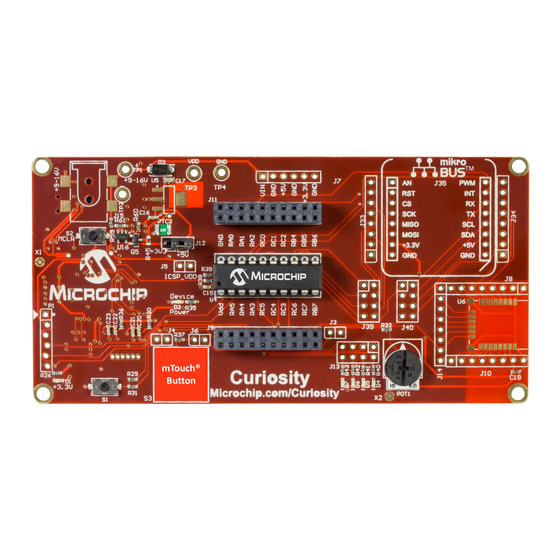
Subscribe to Our Youtube Channel
Summary of Contents for Microchip Technology Curiosity Low Pin Count
- Page 1 Curiosity Low Pin Count (LPC) Development Board User’s Guide 2015-2020 Microchip Technology Inc. DS40001804D...
- Page 2 Technology, and Symmcom are registered trademarks of Microchip Technology Inc. in other countries. GestIC is a registered trademark of Microchip Technology Germany II GmbH & Co. KG, a subsidiary of Microchip Technology Inc., in other countries. All other trademarks mentioned herein are property of their respective companies.
-
Page 3: Table Of Contents
Preface ........................... 4 Chapter 1. Introduction to Curiosity Low Pin Count (LPC) 1.1 Curiosity Low Pin Count (LPC) Development Board Kit Contents ....8 Chapter 2. Getting Started 2.1 Programming the Curiosity Low Pin Count (LPC) Development Board ..10 2.1.1 Programming Using MPLAB®... -
Page 4: Preface
The document is organized as follows: • Chapter 1. “Introduction to Curiosity Low Pin Count (LPC)” – This chapter contains general information regarding the Curiosity LPC Development Board kit contents, layout and power source. - Page 5 Curiosity Low Pin Count Development Board User’s Guide CONVENTIONS USED IN THIS GUIDE This manual uses the following documentation conventions: DOCUMENT CONVENTIONS Description Represents Examples Arial font: Italic characters Referenced books MPLAB IDE User’s Guide Emphasized text ...is the only compiler...
- Page 6 MPLAB REAL ICE in-circuit emulator, MPLAB ICD 3 in-circuit debugger and MPLAB PM3 device programmers. Also included ® are nonproduction development programmers such as PICSTART Plus and PICkit 2 and 3. 2015-2020 Microchip Technology Inc. DS40001804D-page 6...
- Page 7 Curiosity Low Pin Count Development Board User’s Guide CUSTOMER SUPPORT Users of Microchip products can receive assistance through several channels: • Distributor or Representative • Local Sales Office • Field Application Engineer (FAE) • Technical Support Customers should contact their distributor, representative or field application engineer (FAE) for support.
-
Page 8: Chapter 1. Introduction To Curiosity Low Pin Count (Lpc)
CURIOSITY LOW PIN COUNT DEVELOPMENT BOARD USER’S GUIDE Chapter 1. Introduction to Curiosity Low Pin Count (LPC) The Curiosity Low Pin Count (LPC) Development Board supports Microchip’s 8-, 14- ® and 20-pin 8-bit PIC MCUs. Dual-row expansion headers on either side of the socket offer flexibility of connectivity to all pins on the PIC MCUs. - Page 9 FIGURE 1-2: CURIOSITY LOW PIN COUNT (LPC) DEVELOPMENT BOARD REV 4 2015-2020 Microchip Technology Inc. DS40001804D-page 9...
-
Page 10: Chapter 2. Getting Started
BOARD USER’S GUIDE Chapter 2. Getting Started The Curiosity Low Pin Count (LPC) Development Board contains a PICkit On-Board (PKOB) which allows for both low-voltage programming and low-voltage in-circuit debugging for all supported devices. When used with the MPLAB IDE, in-circuit debugging allows the user to run, modify, and troubleshoot their custom software and hardware quickly, without the need for additional debugging tools. - Page 11 5. In the upper left-hand corner of the Project Properties window, click on Starter Kits (PKOB). The window will now show the configuration options for the PKOB programmer, as shown in Figure 2-3. 2015-2020 Microchip Technology Inc. DS40001804D-page 11...
- Page 12 6. In the Option categories drop-down menu, select Program Options; ensure that the Low Voltage Programming mode is selected for Programming mode entry (Figure 2-4). The Curiosity LPC Board is now ready to be programmed. FIGURE 2-4: ENSURE LOW-VOLTAGE PROGRAMMING IS ENABLED 2015-2020 Microchip Technology Inc. DS40001804D-page 12...
- Page 13 7. Once the project is ready to be programmed, simply click on the Make and Program Device button, and MPLAB X IDE will build and compile the code and program the PIC device, as displayed in Figure 2-5. FIGURE 2-5: DEVICE PROGRAMMING 2015-2020 Microchip Technology Inc. DS40001804D-page 13...
-
Page 14: Chapter 3. Troubleshooting
CURIOSITY LOW PIN COUNT DEVELOPMENT BOARD USER’S GUIDE Chapter 3. Troubleshooting This chapter discusses common operational issues and methods to resolve them. THE MCU WILL NOT PROGRAM USING THE PKOB The Curiosity LPC Development Board’s PICkit On-Board (PKOB) uses low-voltage programming. -
Page 15: Appendix A. Schematic
CURIOSITY LOW PIN COUNT DEVELOPMENT BOARD USER’S GUIDE Appendix A. Schematic CURIOSITY LPC DEVELOPMENT BOARD SCHEMATICS FIGURE A-1: CURIOSITY LPC DEVELOPMENT BOARD SCHEMATIC REV 2 (1 OF 1) ECO# DESCRIPTION DATE Move Silkscreen of R14 so it can be read. Swap RB4 and 3-31-2015 RC7 connections. - Page 16 ICSP_FORCE_SPI_SS CTS0_SPI1_SS ACTIVE ERASE 74LVC1G3157 STATUS PKOB4_TDO PKOB4_nRST PKOB4_SWDIO PKOB4_SWCLK Curiosity LPC Designed with USB High Speed R400 5V0_nUSBFLT 5V0_USBGOOD USB2_HS 5V0_USBGOOD 5V0_nUSBFLT VBUS_DETECT 3.3V LDO PIC VDD PG_SYSTEM Curiosity LPC Designed with 2015-2020 Microchip Technology Inc. DS40001804D-page 16...
- Page 17 Schematic FIGURE A-3: CURIOSITY LPC DEVELOPMENT BOARD SCHEMATIC REV 4 (2 OF 4) Main Micro Misc. VDDIO Bypass Caps VDDCORE Bypass Caps Curiosity LPC Designed with Power @J12 VDD_GND Curiosity LPC Designed with 2015-2020 Microchip Technology Inc. DS40001804D-page 17...
- Page 18 ICSP_SPI0_SPCK ISP_SPI1_SPCK ICSP CLK_EN DATA_EN CLK_EN ICSP_SPI0_SPCK (ICSP_SCK) ISP_SPI1_SPCK (SCK_IN) VPP Switch MCLR VPP_ON VPP_GND Curiosity LPC Designed with Virtual Comm Port VCOM (From Target TX) (To Target RX) Curiosity LPC Designed with 2015-2020 Microchip Technology Inc. DS40001804D-page 18...
- Page 19 PGEC PGEC nMCLR nMCLR nMCLR PGED CTS/PIO5 PGEC RTS/PIO6 WAKE_SW AIO2 AIO1 CMD/MLDP HDR-2.54 Male 1X8 STAGGERED AIO0 PIO7 LED/PIO1/SCK MLDP_EV/PIO2/CS RSVD0 WS/PIO3/MOSI RSVD1 PIO4/MISO RSVD2 SPI/PIO POT1 Curiosity LPC Designed with POT1_ALT 2015-2020 Microchip Technology Inc. DS40001804D-page 19...
-
Page 20: Appendix B. General Notes
CURIOSITY LOW PIN COUNT DEVELOPMENT BOARD USER’S GUIDE Appendix B. General Notes mikroBUS™ CLICKS Module 1 is the main click socket, and Module 2 is the secondary socket. Both sockets are fully compatible with a 40-pin PIC device; however, when using 28-pin devices, not all pins are available. -
Page 21: Worldwide Sales And Service
New York, NY Tel: 46-31-704-60-40 Tel: 631-435-6000 Sweden - Stockholm San Jose, CA Tel: 46-8-5090-4654 Tel: 408-735-9110 UK - Wokingham Tel: 408-436-4270 Tel: 44-118-921-5800 Canada - Toronto Fax: 44-118-921-5820 Tel: 905-695-1980 Fax: 905-695-2078 2015-2020 Microchip Technology Inc. DS40001804D-page 21 02/28/20...











Need help?
Do you have a question about the Curiosity Low Pin Count and is the answer not in the manual?
Questions and answers